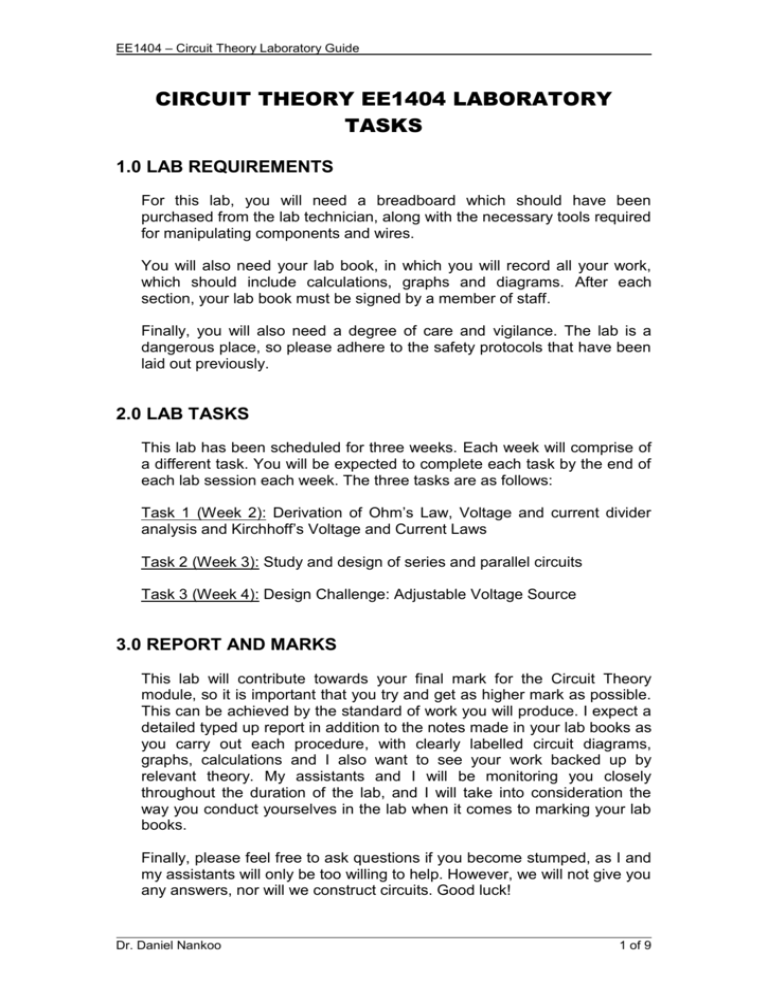CIRCUIT THEORY EE1404 LABORATORY TASKS
advertisement

EE1404 – Circuit Theory Laboratory Guide CIRCUIT THEORY EE1404 LABORATORY TASKS 1.0 LAB REQUIREMENTS For this lab, you will need a breadboard which should have been purchased from the lab technician, along with the necessary tools required for manipulating components and wires. You will also need your lab book, in which you will record all your work, which should include calculations, graphs and diagrams. After each section, your lab book must be signed by a member of staff. Finally, you will also need a degree of care and vigilance. The lab is a dangerous place, so please adhere to the safety protocols that have been laid out previously. 2.0 LAB TASKS This lab has been scheduled for three weeks. Each week will comprise of a different task. You will be expected to complete each task by the end of each lab session each week. The three tasks are as follows: Task 1 (Week 2): Derivation of Ohm’s Law, Voltage and current divider analysis and Kirchhoff’s Voltage and Current Laws Task 2 (Week 3): Study and design of series and parallel circuits Task 3 (Week 4): Design Challenge: Adjustable Voltage Source 3.0 REPORT AND MARKS This lab will contribute towards your final mark for the Circuit Theory module, so it is important that you try and get as higher mark as possible. This can be achieved by the standard of work you will produce. I expect a detailed typed up report in addition to the notes made in your lab books as you carry out each procedure, with clearly labelled circuit diagrams, graphs, calculations and I also want to see your work backed up by relevant theory. My assistants and I will be monitoring you closely throughout the duration of the lab, and I will take into consideration the way you conduct yourselves in the lab when it comes to marking your lab books. Finally, please feel free to ask questions if you become stumped, as I and my assistants will only be too willing to help. However, we will not give you any answers, nor will we construct circuits. Good luck! Dr. Daniel Nankoo 1 of 9 EE1404 – Circuit Theory Laboratory Guide 4.0 TASK 1 – WEEK 1 For this part of the lab you will need the following: Breadboard DC Power supply Digital Multimeter Resistor(s) Part 1 Design the following circuit on your breadboard, with R>3kΩ: + V - R Figure 4.1 Use the appropriate voltmeter and ammeter connections to measure the voltage across (V) R and the current through R (I). Take several readings as you vary the voltage from 0-20V. Tabulate your results, and plot V against I. Measure the gradient of your slope, and check it with the chosen value of R. By what percentage does the slope differ from the chosen value? Can you explain the discrepancy? The gradient of the graph is Ohm’s Law. Part 2 Design the following circuit on your breadboard, where Rn>1kΩ, and R1 ≠ R2 ≠ R3. Make a note of the resistors chosen in your lab book. R1 R2 R3 + V - + V1 - + V2 - + V3 - Figure 4.2 Kirchhoff’s Voltage Law states that the sum of the voltage drops around any closed loop equals the sum of the voltage rises around the loop: V V1 V2 V3 Verify the above law using the digital multimeter to make measurements, and then express the law in terms of the resistances (R1, R2, and R3) and Dr. Daniel Nankoo 2 of 9 EE1404 – Circuit Theory Laboratory Guide current (I). Measure the current, and then calculate it for the voltage chosen to carry out the test and the nominal values of the resistors selected. Considering the tolerances of the resistors, what are the maximum and minimum values of the current that can be observed? Design the following circuit on your breadboard, again choosing and noting down your own resistors, as long as they are >1kΩ, and not equal to each other. R + V - I I1 I2 I3 R1 R2 R3 Figure 4.3 Kirchhoff’s Current Law states that the sum of all currents entering a junction, or any portion of a circuit, equals the sum of all currents leaving the same: I I1 I 2 I 3 Verify the above law using the digital multimeter to make measurements, and then express the law in terms of the resistances (R1, R2, and R3) and voltage (V). Measure the voltage, and then calculate it using the measured current(s) and resistors chosen. What are the maximum and minimum voltages that can be observed when taking the resistor tolerances under consideration? Part 3 Design the following circuit on your breadboard. R1 + VIN R2 VOUT Figure 4.4 The above circuit is a voltage divider. Select values for R1 and R2 so that VOUT is an eighth of VIN, R1 ≠ R2, that they are both greater that 1kΩ, and that the following law is satisfied: Dr. Daniel Nankoo 3 of 9 EE1404 – Circuit Theory Laboratory Guide VOUT R2 VIN R1 R2 Again, use the digital multimeter to measure the necessary values, and verify your readings with calculations. What are the maximum and minimum voltage ratios that can be observed with the nominal resistors chosen? How would you increase and decrease the voltage ratio? Design the following circuit on your breadboard R + VIN - I1 I2 R1 R2 Figure 4.5 Figure 4.5 shows a current divider, governed by the law I1 I R2 R1 R2 I2 I R1 R1 R2 Calculate R1 and R2 such that I1 is 70% of I and I2 is 30% of I. Again, verify your results by making the appropriate measurements and calculations. What are the maximum and minimum values for I1 and I2 that can be observed for the resistors chosen? How would you alter the ratio that the current is split into? LAB BOOKS MUST BE SIGNED AT THIS POINT. Dr. Daniel Nankoo 4 of 9 EE1404 – Circuit Theory Laboratory Guide 5.0 TASK 2 – WEEK 2 You’ll need the same equipment for this part of the lab as you used for the previous task. Here you will be given two simplified circuits, and asked to construct on your breadboards the more complicated versions for both. Part 1 I + 24V - RT = 8kΩ Figure 5.1 The above circuit is the simplified version of the circuit below R1 + 24V - R3 R2 + 12V 0.75mA R4 Figure 5.2 Use parallel and series circuit theory to calculate the resistors required. Construct the above circuit on your breadboards and take the relevant measurements to confirm your results. Dr. Daniel Nankoo 5 of 9 EE1404 – Circuit Theory Laboratory Guide Part 2 Here is another simplified circuit I + 24V - RT = 16.57kΩ Figure 5.3 Derive the unknown values of the resistors in the following circuit. Construct the circuit and take the appropriate measurements. R2 + 24V - R3 R1 R4 R5 R6 7V 0.7mA Figure 5.4 LAB BOOKS MUST BE SIGNED AT THIS POINT. Dr. Daniel Nankoo 6 of 9 EE1404 – Circuit Theory Laboratory Guide 6.0 TASK 3 – WEEK 3 The final task presents a design problem that you are to solve. You are required to design a circuit that provides an adjustable voltage. The specifications for this circuit are: 1. 2. 3. It should be possible to adjust the voltage to any value between -7V and +7V. The load current will be negligible. The circuit should use as little power as possible. You will need to make use of the following components: A potentiometer (i.e. variable resistor) The available resistors in the lab The power supply configured to generate to voltages: +15V and -15V Figure 6.1 shows how you can configure the lab’s DC power supply to generate +15V and -15V simultaneously. Figure 6.1 Figure 6.2 shows the situation. The voltage v is the adjustable voltage. The circuit that uses the output of the circuit being designed is called the load. In this case, the load current is negligible, so i = 0. Load current i=0 Circuit being designed + v - Load circuit Figure 6.2 Dr. Daniel Nankoo 7 of 9 EE1404 – Circuit Theory Laboratory Guide Based on the design criteria, three observations can be made. The adjustability of the potentiometer (variable resistor) can be used to obtain the adjustable voltage v. Both power supplies must be used so that the adjustable voltage can have both positive and negative values. The terminals of the potentiometer cannot be connected directly to the power supplies because the voltage v is not allowed to exceed 15V or -15V. Based on the above, can you design a circuit that meets the objectives and the design specification? You would need to first draw a schematic of your circuit, and consider which of the laws examined in Task 2 can be used to calculate the required resistor values. Prior to building your circuit, please have your circuit diagram checked by a member of staff. Note on the potentiometer A potentiometer is a variable resistor, with three terminals. It has a small adjustable screw that when turned, can adjust the value of the resistance from zero up to the nominal value. The symbol for a variable resistor is shown in Figure 6.3. Figure 6.3 It can be modelled (represented on a diagram and in equations) as two resistors, with a coefficient between 0 and 1 to signify the maximum and minimum resistance values, as shown in Figure 6.4. aRp (1-a)Rp 0<a<1 Figure 6.4 Once your circuit design has been implemented, you will need to carry out tests to check whether the objectives and design specifications have been met. You will need to specify the values of the resistors used (including the potentiometer). You will need to verify if the voltage v can be adjusted to any value in the range -7V to +7V. You will also need to calculate the voltage source currents to ensure that they are less that 100mA (in order to satisfy the condition of modelling the power supplies as ideal voltage sources). Finally, you will have to calculate the power absorbed by the resistors you have chosen, and suggest a way to reduce it. LAB BOOKS MUST BE SIGNED AT THIS POINT. Dr. Daniel Nankoo 8 of 9 EE1404 – Circuit Theory Laboratory Guide 7.0 WHAT NOW? I would like a formal typed up report of the work carried out throughout this lab. You must include clear calculations, diagrams, tables, graphs, a table of contents, page numbers and appropriate headings. Explain each of the theorems covered, and please also mention what you have gained from doing this lab, and what would you like to have done if you had been given extra time. Please leave your completed reports by the end of week 6 in the general office. Dr. Daniel Nankoo 9 of 9









